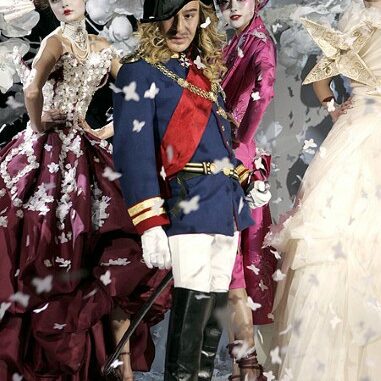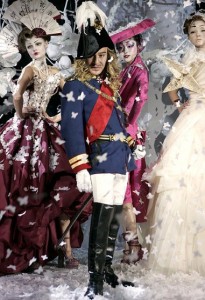
Luxury fashion houses are not dissimilar to all good rock bands. In most cases, creative directors take on the role of lead vocals, providing a recognisable face that both fronts and reflects the label. Where Queen had Freddie Mercury, and The Rolling Stones have Mick Jagger, their fashion counterparts are predominant figures within the industry who directly affect the consumer’s judgment and understanding of a brand. Whether their individual impact and influence is positive or negative depends on their business prowess as well as, perhaps unfairly, the choices made in their personal lives.
Thanks to Donatella, Versace is synonymous with the blonde and glamorous Italian, whilst Chanel brings to mind the immaculately tailored figure, and Ralph Lauren is the very embodiment of his wholesome American lifestyle brand. But what happens when such significant figureheads leave the house with whom he or she has been so inextricably linked; a person whose essence seems to permeate the very core of the brand, with both designer and design house reflecting each other so closely that it appears difficult to comprehend where one ends and the other begins?
It can be under heart-rending circumstances that such a split occurs. One of the most tragic losses to the fashion world in recent years was the death of Alexander McQueen; a brilliant designer reputed and loved for his showmanship, and spectacular and exquisite designs. Perhaps most surprising was his reportedly unassuming attitude towards his work, and the reactions to it from those surrounding him within the industry. As an artist he was one of a kind; his outrageousness and flair continues to influence contemporary fashion designers whose work arguably still fails to match his own in quality and imagination.

In other cases, the separation of designer from design house is often blamed on the indisputable pressure and stress of the fashion industry as a whole. The fast production of large Spring/Summer and Autumn/Winter collections, the resort and cruise collections, the accessory lines, the diffusion lines, the associated external brands – all make for a difficult and urgent working environment. The design process is only a fraction of this pressure; after this comes the conclusive press reception, a stressful experience by anyone’s standards. It was the aforementioned reasons that were reportedly to blame for the recent fall of another of the fashion world’s most notable creators, John Galliano. His story has been rehashed and rewritten numerous times, with each account appearing more fabricated than the last. Enquiries, court summons, and a sacking from Christian Dior followed allegations of Galliano’s racial harassment and abuse; a series of events that rocked the entire industry to its very core. How could Dior continue without the flourish of Galliano’s designs? It was an utterly inconceivable notion for many who were left astounded by the proceedings. But Galliano is not the only designer to experience the crushing psychological weight of excessive expectations. After a noticeable absence from the Balmain Autumn/Winter 2011 show, it was announced in April last year that Creative Director, Christophe Decarnin had parted ways with the French design house. The reported cause was depression and exhaustion, but Decarnin’s closest aids claimed it was actually the result of a severe conflict of interest arising with Balmain’s owner, M. Alain Hivelin. Decarnin was praised for his astounding revival of the label, his brand of glamorous grunge triggering the incredible ‘Balmania’ effect, and numerous fashion trends in the process.
So what happens when a design house is left without its most prestigious and influential figurehead? A label could go one of two ways: continue in an altered direction, relying on the fresh perspective of a new designer and an existing loyal consumer base, or move forward in its existing direction, struggling to progress without compromise or change. Alexander McQueen has adapted using the former method. McQueen’s right-hand man, so to say, Sarah Burton has stepped up to the daunting role as Creative Director of the British luxury brand. A resident of the McQueen house since her graduation in 1997, Burton seemed an appropriate and fitting choice for the job; after all, she spent countless hours working with McQueen on numerous collections for the label. This appointment turned out better than anyone could have predicted. What has followed has been nothing short of miraculous in terms of brand progression and direction. The collections that have been presented since McQueen’s untimely departure have delivered fantastical, delicate creations with a feminine and regal elegance, which have immediacy with the brand whilst simultaneously baring Burton’s unique stamp. That is to say nothing of that royal wedding dress…
But where does the house of Christian Dior stand without Galliano? Rumours suggest Raf Simons, Marc Jacobs, or even relative newcomer Alexander Wang are reportedly being discussed as possible replacements by luxury conglomerate and Dior owner, LVMH. Many industry stalwarts though, including shoe designer extraordinaire Manolo Blahnik, are claiming that a cleaned-up, rehabbed Galliano is the only viable option for the Creative Director of Dior, a job which would never seem quite right in the hands of another. One thing is for sure, the brand is avoiding making a hasty decision. A collective of white coat Dior ateliers have been producing the collections ever since the controversy broke, led by head of the Christian Dior studio, Bill Gaytten.

So after the departure of the ‘face’ of a significant design house, is it possible for them to progress successfully as a brand? There is no doubt that it can be successfully achieved in the right hands, with Burton being an exceptional example of how such an impressive feat is possible. However, it takes an extraordinary talent, precise timing, and an original yet relevant approach for this to work. Will this be the case for the future of Dior? It is impossible to tell. One thing is for certain though; the Galliano era will be thought of fondly as one of the brand’s greatest moments; a flamboyant display of true showmanship, and an exhibition of fashion at its very finest.

Leave a Reply